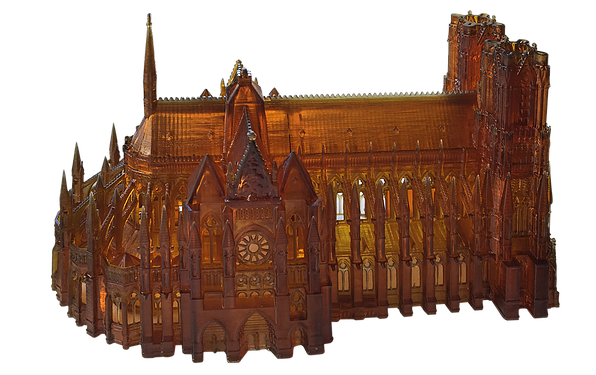Photocentric’s Liquid Crystal Shines a New Light on Resin-based 3D Printing

This cathedral was printed using Photocentric’s Daylight resin, which runs on standard light emitted by a LCD panel. Courtesy of Photocentric.
Latest News
May 25, 2016
Crystal balling the future of additive manufacturing (AM) is an uncertain practice. To quote a certain green, revered master: “Difficult to see. Always in motion is the future.” The only certainty is that AM will improve, just as it has done for the last three decades. The manner of that improvement is less certain.
Hailing from Peterborough, UK, Photocentric has its own vision for the future of 3D printing, and it’s based on resin technology. Rather than relying on expensive lasers or UV light setups, Photocentric has developed a new method of resin curing that uses an inexpensive LCD panel and ordinary light. The result is a series of UK patents, and a new AM system called Liquid Crystal.
 This cathedral was printed using Photocentric’s Daylight resin, which runs on standard light emitted by an LCD panel. Courtesy of Photocentric.
This cathedral was printed using Photocentric’s Daylight resin, which runs on standard light emitted by an LCD panel. Courtesy of Photocentric.Resin AM is valuable primary as a result of its accuracy. Nothing comes without drawbacks, however, and in the case of resin those drawbacks are cost and the occasional problem of an object sticking to the resin tank.
Photocentric claims to have solved both problems with its Daylight brand of resin. The amount of heat produced by light emitted by an LCD panel is far less than that produced by UV or lasers. Less heat means less spillover to surrounding resin, which, according to the company, makes it less likely an object will stick to the resin tank during printing, even when using a bottom-up process. As for cost, as was noted earlier, LCD panels are a much less expensive light source than standard resin curing options.
The Liquid Crystal AM systems that take advantage of the newly developed technology are fairly standard for resin 3D printers. Technical stats for the 10” are below:
- Build Envelope 7.87 x 3.94 x 7.87 in. (200 x 100 x 200 mm)
- Layer Thickness 25 micron
- XY Resolution 220 micron
- Build Speed 20 sec/layer +8 seconds mechanical at 100 micron
Below you’ll find video instructions on setup and use of Photocentric’s Liquid Crystal systems.
Source: Photocentric
Subscribe to our FREE magazine, FREE email newsletters or both!
Latest News
About the Author
John NewmanJohn Newman is a Digital Engineering contributor who focuses on 3D printing. Contact him via [email protected] and read his posts on Rapid Ready Technology.
Follow DERelated Topics






